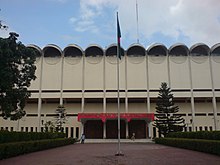National Museum of Bangladesh
The Bangladesh National Museum is a state-run museum in Dhaka , in the Shahbag district . It contains collections in the fields of archeology , art , history , natural history and ethnology . It also has a public education department, a conservation laboratory and an administrative department. It has 4 branches in Chittagong , Sylhet and Maimansingh , as well as in Dhaka itself in the Mughal palace Ahsan Manzil .
history
The previous museum was inaugurated on August 7, 1913 under the name Dhaka Museum . It was founded on the background of the partition of Bengal carried out by Lord Curzon in 1905 and the resulting growth of Dhaka. The collection of this museum grew rapidly, the first expansion from one to three rooms took place in June 1914. This collection, which then comprised 379 objects, became accessible to the public on August 25, 1914. The museum's first curator was named Nalini Kanta Bhattasali.
The museum developed a close collaboration with the University of Dhaka , which did not have its own historical collection. In 1936 the museum management was reorganized accordingly, taking this cooperation into account and in which the vice-chancellor of the university presided over the Dhaka Museum Committee as president. In 1947 the university took over the management of the museum entirely from the provincial government. After several internal administrative changes, the museum was placed directly under the government of East Pakistan in 1970 .
After the founding of Bangladesh in 1971, the country's first prime minister, Shaikh Mujibur Rahman, showed interest in a national museum that should document the history of the country's struggle for freedom. It was also he who first referred to the Dhaka Museum as the Bangladesh National Museum . He donated several exhibits, including a flag. The museum was not officially inaugurated as a national museum until 1983.
Collections
Objects from the fields of archeology , art , history , natural history and ethnology are shown in 44 rooms . The archaeological collection is particularly noteworthy for the Hindu and Buddhist sculptures. In the field of natural history, a focus is on the representation of the natural heritage of Bangladesh. Ten rooms are dedicated to the plants and animals as well as the stones and minerals of Bangladesh. In the history section, there are two main rooms dedicated to the history of the founding of the country, taking into account the Bengali language movement and the Bangladesh war . Furthermore, the works of Zainul Abedin are worth mentioning in the art collection, which depict the misery of the hunger period in Bangladesh.
Individual evidence
- ^ History. Bangladesh National Museum, accessed December 2, 2017 .
- ^ Bangladesh National Museum. Banglapedia, accessed December 7, 2017 .












